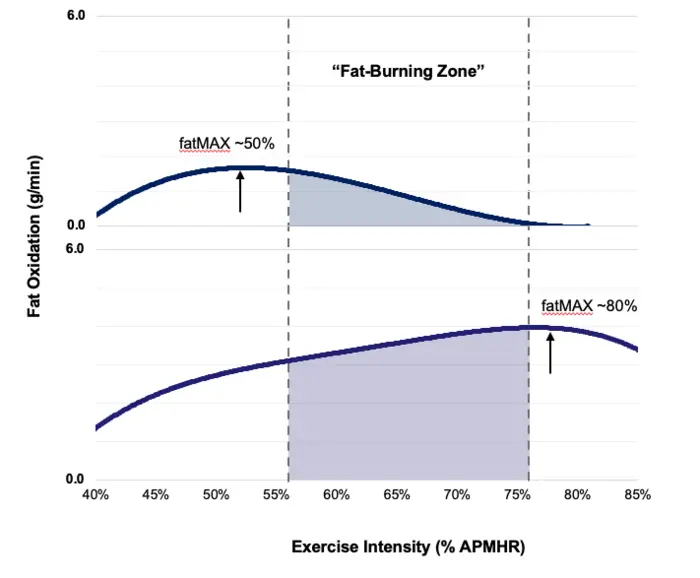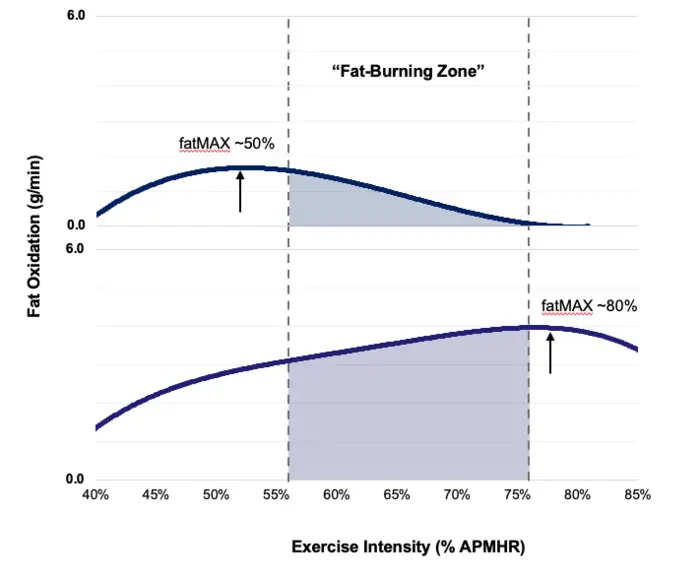New York, NY [August 10, 2023]—The best heart rate for burning fat differs for each individual and often does not align with the “fat burning zone” on commercial exercise machines, Icahn School of Medicine at Mount Sinai researchers report.

Credit: Hannah Kittrell, Mount Sinai Physiolab and AIMS Lab at Icahn Mount Sinai
New York, NY [August 10, 2023]—The best heart rate for burning fat differs for each individual and often does not align with the “fat burning zone” on commercial exercise machines, Icahn School of Medicine at Mount Sinai researchers report.
Instead, the researchers said, clinical exercise testing—a diagnostic procedure to measure a person’s physiological response to exercise—may be a more useful tool to help individuals achieve intended fat loss goals. The study, which used a machine learning-based modeling approach, was published online today in Nutrition, Metabolism and Cardiovascular Disease.
“People with a goal of weight or fat loss may be interested in exercising at the intensity which allows for the maximal rate of fat burning. Most commercial exercise machines offer a ‘fat-burning zone’ option, depending upon age, sex, and heart rate,” says lead author Hannah Kittrell, MS, RD, CDN, a PhD candidate at Icahn Mount Sinai in the Augmented Intelligence in Medicine and Science laboratory. “However, the typically recommended fat-burning zone has not been validated, thus individuals may be exercising at intensities that are not aligned with their personalized weight loss goals.”
Ms. Kittrell is also Director of the Mount Sinai Physiolab, a clinical body composition and exercise physiology laboratory at Mount Sinai Morningside.
The term FATmax is sometimes used to represent the exercise intensity and associated heart rate at which the body reaches its highest fat-burning rate during aerobic exercise. At this point, fat is a significant fuel source and therefore this intensity may be of interest to those seeking to optimize fat loss during workouts.
As part of the study, the researchers compared heart rate at FATmax, as measured during a clinical exercise test, to predicted heart rate at percentages of maximal effort within the typically recommended “fat-burning zone.” In a sample of 26 individuals, the researchers found that there was poor agreement between measured and predicted heart rate, with a mean difference of 23 beats per minute between the two measures. This suggests that general recommendations for a “fat-burning zone” may not provide accurate guidance.
Next, the researchers plan to study whether individuals who receive a more personalized exercise prescription demonstrate more weight and fat loss, as well as improvement of metabolic health markers that identify health risks like type 2 diabetes, obesity, and heart disease.
“We hope that this work will inspire more individuals and trainers to utilize clinical exercise testing to prescribe personalized exercise routines tailored to fat loss. It also emphasizes the role that data-driven approaches can have toward precision exercise,” says senior author Girish Nadkarni, MD, MPH, Irene and Dr. Arthur M. Fishberg Professor of Medicine at Icahn Mount Sinai, Director of The Charles Bronfman Institute of Personalized Medicine, and System Chief, Division of Data-Driven and Digital Medicine, Department of Medicine.
The paper is titled “Discrepancy between predicted and measured exercise intensity for eliciting the maximal rate of lipid oxidation.”
The remaining authors are Fred J. DiMenna (The Mount Sinai Hospital), Avigdor D. Arad (Tel Aviv Medical Center), Wonsuk Oh (Icahn Mount Sinai), Ira Hofer (Icahn Mount Sinai), Ryan W. Walker (Icahn Mount Sinai), Ruth J.F. Loos (Icahn Mount Sinai & University of Copenhagen), and Jeanine B. Albu (Icahn Mount Sinai).
-####-
About the Icahn School of Medicine at Mount Sinai
The Icahn School of Medicine at Mount Sinai is internationally renowned for its outstanding research, educational, and clinical care programs. It is the sole academic partner for the eight- member hospitals* of the Mount Sinai Health System, one of the largest academic health systems in the United States, providing care to a large and diverse patient population.
Ranked 14th nationwide in National Institutes of Health (NIH) funding and among the 99th percentile in research dollars per investigator according to the Association of American Medical Colleges, Icahn Mount Sinai has a talented, productive, and successful faculty. More than 3,000 full-time scientists, educators, and clinicians work within and across 44 academic departments and 36 multidisciplinary institutes, a structure that facilitates tremendous collaboration and synergy. Our emphasis on translational research and therapeutics is evident in such diverse areas as genomics/big data, virology, neuroscience, cardiology, geriatrics, as well as gastrointestinal and liver diseases.
Icahn Mount Sinai offers highly competitive MD, PhD, and Master’s degree programs, with current enrollment of approximately 1,300 students. It has the largest graduate medical education program in the country, with more than 2,000 clinical residents and fellows training throughout the Health System. In addition, more than 550 postdoctoral research fellows are in training within the Health System.
A culture of innovation and discovery permeates every Icahn Mount Sinai program. Mount Sinai’s technology transfer office, one of the largest in the country, partners with faculty and trainees to pursue optimal commercialization of intellectual property to ensure that Mount Sinai discoveries and innovations translate into healthcare products and services that benefit the public.
Icahn Mount Sinai’s commitment to breakthrough science and clinical care is enhanced by academic affiliations that supplement and complement the School’s programs.
Through the Mount Sinai Innovation Partners (MSIP), the Health System facilitates the real-world application and commercialization of medical breakthroughs made at Mount Sinai. Additionally, MSIP develops research partnerships with industry leaders such as Merck & Co., AstraZeneca, Novo Nordisk, and others.
The Icahn School of Medicine at Mount Sinai is located in New York City on the border between the Upper East Side and East Harlem, and classroom teaching takes place on a campus facing Central Park. Icahn Mount Sinai’s location offers many opportunities to interact with and care for diverse communities. Learning extends well beyond the borders of our physical campus, to the eight hospitals of the Mount Sinai Health System, our academic affiliates, and globally.
——————————————————-
* Mount Sinai Health System member hospitals: The Mount Sinai Hospital; Mount Sinai Beth Israel; Mount Sinai Brooklyn; Mount Sinai Morningside; Mount Sinai Queens; Mount Sinai South Nassau; Mount Sinai West; and New York Eye and Ear Infirmary of Mount Sinai.
DOI
10.1016/j.numecd.2023.07.014
Method of Research
Observational study
Subject of Research
People
Article Title
Discrepancy between predicted and measured exercise intensity for eliciting the maximal rate of lipid oxidation
Article Publication Date
15-Jul-2023





